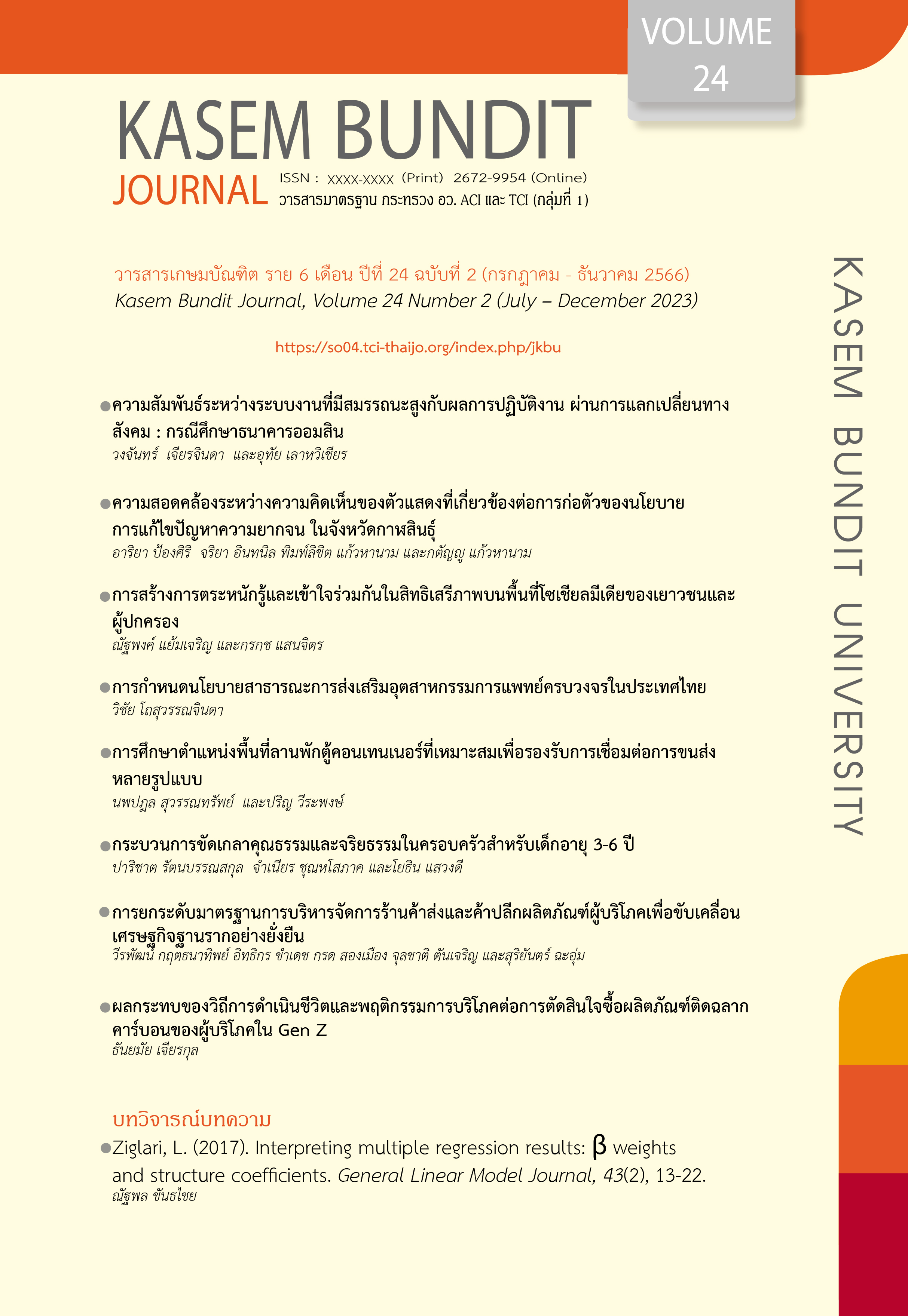ความสัมพันธ์ระหว่างระบบงานที่มีสมรรถนะสูงกับผลการปฏิบัติงาน ผ่านการแลกเปลี่ยนทางสังคม : กรณีศึกษาธนาคารออมสิน
Keywords:
ระบบงานที่มีสมรรถนะสูง , การแลกเปลี่ยนทางสังคม , ผลการปฏิบัติงานขององค์การAbstract
วัตถุประสงค์ เพื่อวิเคราะห์อิทธิพลทางตรงและทางอ้อมของระบบงานที่มีสมรรถนะสูงต่อผลการปฏิบัติงานขององค์การ ผ่านการแลกเปลี่ยนทางสังคม วิธีการวิจัย การวิจัยเชิงสำรวจจากตัวอย่างโดยเก็บรวบรวมข้อมูลจากบุคลากรของธนาคารออมสินจำนวน 310 คน ที่ปฏิบัติงานในสำนักงานใหญ่และสาขาธนาคารในกรุงเทพมหานคร โดยใช้วิธีสุ่มตัวอย่างแบบชั้นภูมิเชิงสัดส่วน เครื่องมือที่ใช้ในการวิจัยได้แก่ แบบสอบถามที่ผ่านการทดสอบความเชื่อถือได้ด้วยวิธีของครอนบาค การวิเคราะห์ข้อมูลโดยใช้โมเดลสมการโครงสร้าง ผลการวิจัย ระบบงานที่มีสมรรถนะสูงมีอิทธิพลต่อผลการปฏิบัติงานขององค์การและการแลกเปลี่ยนทางสังคม การแลกเปลี่ยนทางสังคมมีอิทธิพลทางตรงต่อผลการปฏิบัติงานขององค์การ ระบบงานที่มีสมรรถนะสูงมีอิทธิพลทางอ้อมผ่านการแลกเปลี่ยนทางสังคมต่อไปยังผลการปฏิบัติงานขององค์การ ซึ่งเป็นการส่งผ่านอิทธิพลแบบบางส่วนของความสัมพันธ์ นัยทางทฤษฎี/นโยบาย องค์การควรให้ความสำคัญต่อการแลกเปลี่ยนทางสังคมในการเพิ่มผลการปฏิบัติงานขององค์การมากกว่าการให้ความสำคัญต่อระบบงานที่มีสมรรถนะสูงแต่เพียงด้านเดียวสำหรับการเติบโตขององค์การ
References
relationship between strategic HRM and organizational performance in Chinese banks. Journal of Innovation & Knowledge, 3, 115-122.
Allen, N. J., & Meyer, J. P. (1990). The measurement and antecedents of affective, continuance and normative commitment to the organization. Journal of Occupational Psychology, 63, 1-18.
Appelbaum, E., Bailey, T., Berg, P., & Kalleberg, A. (2000). Manufacturing advantage: Why high-performance work systems pay off. ILR Press.
Becker, B. E., & Huselid, M. A. (1998). High performance work systems and firm performance: A synthesis of research and managerial implications. Research in Personnel and Human Resource Management, 16, 53-102.
Bharadwaj, A. (2000). A resource-based perspective on information technology capability and firm performance: An empirical investigation. MIS Quarterly, 24(1), 169-196.
Bohlander, G., & Snell, S. (2004). Managing human resource. Thomson South-Western, Ohio.
Burns, N. & Grove, S. K. (1993). The practice of nursing research: Conduct, critique, & utilization (4th ed.). W.B. Saunders company.
Cropanzano, R., & Mitchell, M. S. (2005). Social exchange theory: An interdisciplinary review. Journal of Management, 31(6), 874-900.
Daft, R. L. (2000). Organization theory and design (7th ed.). South-Western College Publishing.
Datta, D. K., Guthrie, J. P., & Wright, P. M. (2005). Human resource management and labor productivity: Does industry matter? The Academy of Management Journal, 48(1), 135-145.
Eisenberger, R., Huntington, R., Hutchison, S., & Sowa, D. (1986). Perceived organizational support. Journal of Applied Psychology, 71, 500-507.
Erden, A., & Erden, H. (2009). Predicting organizational trust level of school managers and teachers at elementary schools. Social and Behavioral Sciences, 1, 2180-2190.
Fu, N., Bosak, J., Flood, P. C., & Ma, Q. (2018). Chinese and Irish professional service firms compared: Linking HPWS, organizational coordination, and firm performance. Journal of Business Research, 95(1), 1-11.
Gorsuch, R. L. (1983). Factor analysis (2nd ed.). Erlbaum.
Hackman, J. R., & Oldham, G. R. (1975). Development of the job diagnostic survey. Journal of Applied Psychology, 60, 159-170.
Hair, J. F., Black, W. C., Babin, B. J., Anderson, R. E., & Tatham, R. L. (2006). Multivariate data analysis (vol. 6). Pearson.
Hair J. F., Black, W. C., Babin, B. J., & Anderson, R. E. (2010). Multivariate data analysis: A global perspective 7th ed.). Pearson.
Kaplan, R. S., & Norton, D. P. (1996). Balanced scorecard: Translating strategy into action. Harvard Business School Press.
Mey, M., Werner, A., & Theron, A. (2014). The influence of perceptions of organizational trust and fairness on employee citizenship. Problems and Perspectives in Management, 12(3), 99-105.
Noe, R. A., Hollenbeck, J. R., Gerhart, B., & Wright, P. M. (2020). Fundamentals of human resource management (8th ed.). McGraw-Hill Education.
Nunnally, J. C. (1978). Psychometric theory (2nd ed.). McGraw Hill.
Organ, D. W., Podsakoff, P. M., & MacKenzie, S. B. (2006). Organizational citizenship behavior: Its nature antecedents and consequences. Sage.
Pfeffer, J. (1994). Competitive advantage through people: Unleashing the power of the workforce. Harvard Business School Press.
Ramsey, H., Scholarios, D., & Harley, B. (2000). Employees and high performance work systems: Testing inside the black box. British Journal of Industrial Relations, 38, 501-531.
Rubel, M. R. B., Rimi, N. N., Yusliza, M. Y., & Kee, D. M. H. (2018). High commitment human resource management practices and employee service behavior: Trust in management as mediator. IIMB Management Review, 30(4), 316-329.
Schermerhorn, J. R. (1996). Management and organizational behavior: Essentials. John Willey and Son, Inc.
Takeuchi, R., Lepak, D. P., Wang, H., & Takeuchi, K. (2007). An empirical examination of the mechanisms mediating between high performance work systems and the performance of Japanese organizations. Journal of Applied Psychology, 92(4), 1069-1083.
Tippins, M. J., & Sohi, R. S. (2003). "IT competency and firm performance: Is organizational learning a missing link?". Strategic Management Journal, 24(8), 745-761.
Thibaut, J. W., & Kelley, H. H. (1959). The social psychology of groups. Wiley.
Van Buren, M. E., & Werner, J. M. (1996). High performance work systems. Business and Economic Review, 43(1), 15-23.
Downloads
Published
How to Cite
Issue
Section
License
Copyright (c) 2023 KASEM BUNDIT JOURNAL

This work is licensed under a Creative Commons Attribution-NonCommercial-NoDerivatives 4.0 International License.
ทัศนคติ ความคิดเห็นใด ๆ ที่ปรากฏในวารสารเกษมบัณฑิตฉบับนี้เป็นของผู้เขียน โดยเฉพาะ มหาวิทยาลัยเกษมบัณฑิตและบรรณาธิการ ไม่จำเป็นต้องมีความเห็นพ้องด้วย







